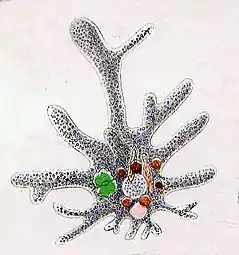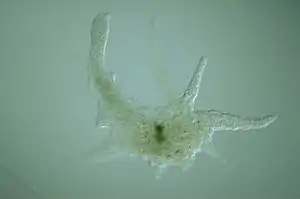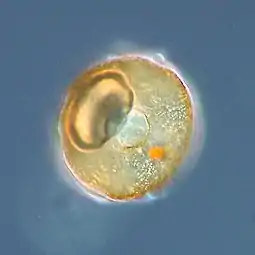Tubulinea
The Tubulinea are a major grouping of Amoebozoa, including most of the more familiar amoebae genera like Amoeba, Arcella, Difflugia and Hartmannella.
| Tubulinea | |
|---|---|
 | |
| Amoeba proteus | |
| Scientific classification | |
| Domain: | Eukaryota |
| Phylum: | Amoebozoa |
| Subphylum: | Lobosa |
| Class: | Tubulinea Smirnov et al. 2005 |
| Subclasses & Orders | |
| |
Characteristics
During locomotion most Tubulinea have a roughly cylindrical form or produce numerous cylindrical pseudopods. Each cylinder advances by a single central stream of cytoplasm, granular in appearance, and has no subpseudopodia. This distinguishes them from other amoeboid groups, although in some members this is not the normal type of locomotion.
Classification
This class was anticipated by some biologists like Jahn, who grouped all amoebae with granular pseudopodia together,[1] but most split the lobose amoebae into testate Testacealobosia and naked Gymnamoebia. These latter arepolyphyletic, but molecular trees by Bolivar et al.[2] identified a core monophyletic subgroup. Subsequent studies showed the testate lobose amoebae belong to the same group, which was thus renamed Lobosea sensu stricto[3] or Tubulinea.[4]
Taxonomy
Class Tubulinea Smirnov et al. 2005 stat. nov. Adl et al. 2018[5][6][7]
- Subclass Corycidia Kang et al. 2017 stat. nov. Adl et al. 2018
- Order Trichosida Moebius 1889
- Family Trichosphaeriidae Sheehan & Banner 1973a
- Family Microcoryciidae de Saedeleer 1934
- Order Trichosida Moebius 1889
- Subclass Echinamoebia Cavalier-Smith 2016 stat. nov. Adl et al. 2018
- Order Echinamoebida Cavalier-Smith 2004 em. 2011
- Family Vermamoebidae Cavalier-Smith & Smirnov 2011
- Family Echinamoebidae Page 1975
- Order Echinamoebida Cavalier-Smith 2004 em. 2011
- Subclass Elardia Kang et al. 2017 stat. nov. Adl et al. 2018
- Superorder Leptomyxia Cavalier-Smith 2016
- Order Leptomyxida Pussard & Pons 1976 em. Page 1987
- Family Flabellulidae Bovee & Jahn, 1967 ex Bovee 1970
- Family Gephyramoebidae Pussard & Pons 1976
- Family Leptomyxidae Goodey 1915
- Order Leptomyxida Pussard & Pons 1976 em. Page 1987
- Superorder Eulobosia Cavalier-Smith 2016
- Order Euamoebida Lepşi 1960 em. Cavalier-Smith 2016
- Family Nolandellidae Cavalier-Smith 2011
- Family Hartmannellidae Singh 1951 em. Smirnov et al. 2011
- Family Amoebidae (Ehrenberg 1838) Page 1987
- Order Arcellinida Kent 1880
- Family Bipseudostomatidae Snegovaya & Alekperov 2005
- Family Mississippiellidae Huddleston & Haman 1985
- Family Shamkiriidae Snegovaya & Alekperov 2005
- Suborder Phryganellina Bovee 1985
- Family Phryganellidae Jung 1942
- Family Cryptodifflugiidae Jung 1942
- Suborder Organoconcha Kosakyan et al. 2016
- Family Microchlamyiidae Ogden 1985
- Suborder Glutinoconcha Kosakyan et al. 2016
- Infraorder Volnustoma Kosakyan et al. 2016
- Family Heleoperidae Jung 1942
- Infraorder Hyalospheniformis Kosakyan et al. 2016
- Family Hyalospheniidae Jung, 1942 [Nebelidae Taranek 1882]
- Infraorder Excentrostoma Kosakyan et al. 2016
- Family Centropyxidae
- Family Plagiopyxidae
- Infraorder Longithecina Kosakyan et al. 2016
- Family Lesquereusiidae [Paraquadrulidae Deflandre 1953]
- Family Difflugiidae Wallich 1864
- Infraorder Sphaerothecina Kosakyan et al. 2016
- Family Cucurbitellidae Gomaa et al. 2017
- Family Distomatopyxidae Bonnet 1970
- Family Lamtopyxidae Bonnet 1974
- Family Netzeliidae Kosakyan et al. 2016 [Cyclopyxidae Schönborn 1989]
- Family Arcellidae Ehrenberg 1832
- Family Trigonopyxidae Loeblich 1964
- Infraorder Volnustoma Kosakyan et al. 2016
- Order Euamoebida Lepşi 1960 em. Cavalier-Smith 2016
- Superorder Leptomyxia Cavalier-Smith 2016
References
- Jahn; Bovee; Jahn (1979). How to know the protozoa. Wm. C. Brown Company Publishers. ISBN 0-697-04759-8.
- Bolivar, I.; Fahrni, J.F.; Smirnov, A. & Pawlowski, J. (2001). "SSU rRNA-based Phylogenetic Position of the Genera Amoeba and Chaos (Lobosea, Gymnamoebia): The Origin of Gymnamoebae Revisited". Molecular Biology and Evolution. 18 (12): 2306–2314. doi:10.1093/oxfordjournals.molbev.a003777. PMID 11719580.
- Cavalier-Smith, T.; Chao, E.-Y; Oates, B. (2004). "Molecular phylogeny of the Amoebozoa and evolutionary significance of the unikont Phalansterium". European Journal of Protistology. 40: 21–48. doi:10.1016/j.ejop.2003.10.001.
- Smirnov, A.V.; Nassonova, E.S.; Berney, C.; Fahrni, J.; Bolivar, I. & Pawlowski, J. (2005). "Molecular phylogeny and classification of the lobose amoebae". Protist. 156 (2): 129–142. doi:10.1016/j.protis.2005.06.002. PMID 16171181.
- Kang S, Tice AK, Spiegel FW, Silberman JD, Pánek T, Cepicka I, et al. (September 2017). "Between a Pod and a Hard Test: The Deep Evolution of Amoebae". Molecular Biology and Evolution. 34 (9): 2258–2270. doi:10.1093/molbev/msx162. PMC 5850466. PMID 28505375.
- Adl, Sina M.; Bass, David; Lane, Christopher E.; Lukeš, Julius; Schoch, Conrad L.; Smirnov, Alexey; Agatha, Sabine; Berney, Cedric; Brown, Matthew W. (2018-09-26). "Revisions to the Classification, Nomenclature, and Diversity of Eukaryotes". Journal of Eukaryotic Microbiology. 66 (1): 4–119. doi:10.1111/jeu.12691. PMC 6492006. PMID 30257078.
- Lahr, Daniel J.G.; Kosakyan, Anush; Lara, Enrique; Mitchell, Edward A.D.; Morais, Luana; Porfirio-Sousa, Alfredo L.; Ribeiro, Giulia M.; Pánek, Tomáš; Kang, Seungho; Brown, Matthew W. (2019). "Phylogenomics and Morphological Reconstruction of Arcellinida Testate Amoebae Highlight Diversity of Microbial Eukaryotes in the Neoproterozoic". Current Biology. 29 (6): 991–1001. doi:10.1016/j.cub.2019.01.078.




